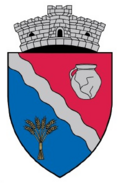Ciugud
|
Ciugud Schenkendorf Maroscsüged / Csüged |
||||
|
||||
| Basic data | ||||
|---|---|---|---|---|
| State : |
|
|||
| Historical region : | Transylvania | |||
| Circle : | Alba | |||
| Coordinates : | 46 ° 3 ' N , 23 ° 37' E | |||
| Time zone : | EET ( UTC +2) | |||
| Height : | 240 m | |||
| Area : | 43.77 km² | |||
| Residents : | 3,048 (October 20, 2011) | |||
| Population density : | 70 inhabitants per km² | |||
| Postal code : | RO-517240 | |||
| Telephone code : | (+40) 02 58 | |||
| License plate : | FROM | |||
| Structure and administration (as of 2016) | ||||
| Community type : | local community | |||
| Structure : | Ciugud, Drâmbar , Hăpria , Limba , Șeușa , Teleac | |||
| Mayor : | Gheorghe Dămian ( PSD ) | |||
| Postal address : | Str. Principală, no. 157 loc. Ciugud, jud. Alba, RO-517240 |
|||
| Website : | ||||
Ciugud [ tʃiuˈgud ] ( German Schenkendorf , Hungarian Maroscsüged or Csüged ) is a Romanian municipality in the Alba district in Transylvania .
Geographical location
Ciugud is located on the western edge of the Zekesch Highlands (Podișul Secașelor) in the southwest of the Transylvanian Basin , in the wide valley of the Mureș (Mieresch) on its left side. The district capital Alba Iulia is located approx. 9 kilometers northwest (approx. 6 kilometers, as the crow flies). With its five incorporated villages, the municipality extends in a landscape of meadows - near the Mureș - and hills on a total area of 4376.98 hectares. 2023 hectares of the total area are used for arable farming, 1136 for cattle breeding, 23 hectares for orchards and viticulture; 159 hectares are forests.
history
There are several protected archaeological sites on the territory of the municipality. In the area of the bentonite mining site in Ciugud, finds have been dated back to the Neolithic. In the area of the incorporated town of Hăpria , called Vadul Bălgradului by the locals , remains of dwellings from the Roman era were found and in the area of the town of Teleac , known by the locals as Grușeț - Hârburi , finds were made which were assigned to the Hallstatt period. Since 1987 - the beginning of the mining of bentonite - the archaeological finds have been brought to the National Museum of Alba Iulia. More than 80% of the archaeological site was destroyed by the work on the mining site.
Ciugud was first mentioned in 1264 in lists of the Catholic diocese of Oradea . In the Middle Ages, the inhabitants of the places were serfs of the Roman Catholic monastery of Alba Iulia , until serfdom was abolished in Transylvania in 1852.
population
The population of the entire municipality developed as follows:
| census | Ethnic composition | |||||||
|---|---|---|---|---|---|---|---|---|
| year | population | Romanians | Hungary | German | other | |||
| 1850 | 2,922 | 2,863 | 10 | - | 49 | |||
| 1900 | 3.710 | 3,693 | 10 | 7th | - | |||
| 1930 | 4,483 | 4,465 | 2 | 2 | 14th | |||
| 1966 | 3,355 | 3,354 | 1 | - | - | |||
| 2002 | 2,664 | 2,643 | 10 | - | 11 | |||
The highest population of the municipality Ciugud (4579) was registered in 1941, of it in the village Drâmbar (Brunndorf) 1227 (exclusively Romanians). The highest number of Germans (7) was determined in 1900, six of them in the incorporated village of Limba (Warthe) , which from 1958 to 2004 was called "Dumbrava".
In 2002 the population of the municipality Ciugud was 2,664, of which 2,643 were Romanians, ten Magyars, five Roma and five were Ukrainians .
Attractions
- The Romanian Orthodox Church
- In the center of Ciugud the 7 meter high monument in honor of the Romanian heroes of the First and Second World Wars, inaugurated in 1968 .
- The wooden church Ioachim și Ana in the incorporated village of Drâmbar .
Web links
Individual evidence
- ↑ 2011 census in Romania ( MS Excel ; 1.3 MB)
- ↑ Mayoral elections 2016 in Romania ( MS Excel ; 256 kB)
- ^ Dictionary of the localities in Transylvania
- ↑ a b List of the Romanian Ministry of Culture, updated 2010 (PDF; 7.10 MB)
- ↑ Institute Of Archeology - Hăpria at cimec.ro accessed on November 5, 2012 (Romanian)
- ↑ Report on the archaeological research in the village of Șeușa (Romanian)
- ^ Website of the municipality of Ciugud ( Memento of April 18, 2010 in the Internet Archive )
- ↑ Census, last updated October 30, 2008, p. 74 (Hungarian; PDF; 1.2 MB)


